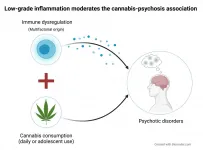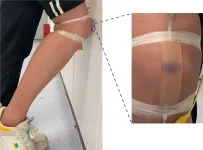Study: Complexity holds steady as writing systems evolve
2021-06-16
(Press-News.org) A new paper in the journal Cognition examines the visual complexity of written language and how that complexity has evolved.
Using computational techniques to analyze more than 47,000 different characters from 133 living and extinct scripts, co-authors Helena Miton of the Santa Fe Institute and Oliver Morin of the Max Planck Institute for the Science of Human History, addressed several questions around why and how the characters of different writing systems vary in how complex they appear.
"When we started this project, we wanted to test whether you find a general simplification of characters over time," Miton says. "Do scripts simplify their characters as they spend more time exposed to evolutionary pressures from the humans who are learning them and using them?"
We interact with most types of writing through our visual system, so the characters and scripts that make up the hundreds of writing systems humans have used through history are limited to, and optimized for, the way our brains process visual information. Part of that optimization, write the authors, is the graphic complexity of the characters in a script.
Morin illustrates this in a Twitter thread, offering an image of two characters, one apparently more complex, with more detail and contours, than the other. He writes, "Why care about this? Because your brain does. Simpler letters are easier and faster to process." He goes on, "Any small improvements in processing speed can accumulate into big-time gains for readers. Letters are under pressure to simplify, but also have to carry information."
A highly cited study from 2005 suggests that writing systems tend to settle on a common solution to these pressures: using about three strokes per character. In this new paper, Miton and Morin push back against that finding, and others, by studying a larger and broader set of scripts and incorporating new methods that account for cultural evolution and lineages in writing.
Miton and Morin used two measures of graphic complexity to compare characters and scripts from the massive dataset drawn from geographic locations around the world. The first measure, "perimetric" complexity, is a ratio of inked surface to its perimeter. The other measure, "algorithmic," is the number of bytes needed to store a compressed image of a character.
Among their results, they found that large scripts -- those with more than 200 characters -- had, on average, more complex characters than scripts with a smaller number of characters. Relatedly, the study suggests that the main driver of characters' complexity was which linguistic units (e.g., phoneme, syllable, entire word, etc.) the characters encode.
They were surprised to find little evidence for evolutionary change in complexity: scripts that were invented in the past 200 years used characters of similar complexity to those that have been around for longer. In forthcoming work led by Piers Kelly, Miton and Morin investigate whether written characters follow an optimization process that happens more quickly than was captured in the current study's dataset.
INFORMATION:
ELSE PRESS RELEASES FROM THIS DATE:
2021-06-16
The presence of pro-inflammatory cytokines in the blood can boost the effects of daily cannabis use and heighten the risk of developing psychosis in adulthood. Similar results have been observed, also in the presence of cytokines, when cannabis is used during adolescence. Psychotic disorders have symptoms such as delirium, loss of a sense of reality, hallucinations, hearing voices, and cognitive and social impairments.
A study by researchers at the University of São Paulo's Ribeirão Preto Medical School (FMRP-USP) in Brazil, reported in an article in ...
2021-06-16
RUDN University biologist studied the aggressive impact of environmental factors (water, salts, and ozone) on ultrathin nanofibers of biopolymers. The results will help choosing suitable bioplastic depending on the use; for example, for medical implants, biodegradable packaging or filters for water cleaning. The results are published in the journal Polymers.
Bioplastics are an alternative to ordinary plastics. They are obtained from waste of plant and food industry. The safe composition allows using them as filters for gases and liquids, as "sponges" for cleaning reservoirs and medical implants. Depending on the field ...
2021-06-16
NEW YORK, NY (June 16, 2021)--Spectacular images of a molecule that shuttles omega-3 fatty acids into the brain may open a doorway for delivering neurological therapeutics to the brain.
"We've managed to obtain a three-dimensional structure of the transporter protein that provides a gateway for omega-3s to enter the brain. In this structure, we can see how omega-3s bind to the transporter. This information may allow for the design of drugs that mimic omega-3s to hijack this system and get into the brain," says first author Rosemary J. Cater, PhD, a Simons Society Fellow in the Mancia Lab at Columbia University Vagelos College of Physicians and Surgeons.
The study was published online on June 16 in the journal Nature.
A major challenge in treating ...
2021-06-16
Bay Area scientists have captured the real-time electrical activity of a beating heart, using a sheet of graphene to record an optical image -- almost like a video camera -- of the faint electric fields generated by the rhythmic firing of the heart's muscle cells.
The graphene camera represents a new type of sensor useful for studying cells and tissues that generate electrical voltages, including groups of neurons or cardiac muscle cells. To date, electrodes or chemical dyes have been used to measure electrical firing in these cells. But electrodes and dyes measure the voltage at one point only; a graphene sheet measures the voltage ...
2021-06-16
Should zoos display legally protected species that have been smuggled out of their range countries? A new study suggests that a pause and rethink may be needed, as it reports that accredited zoos have acquired a rare and legally protected reptile, the earless monitor lizard endemic to Borneo, without any evidence that the animals were legally exported.
The earless monitor lizard occurs only on the island of Borneo and has been described as a "miniature Godzilla" and "the Holy Grail of Herpetology." Discovered by western scientists almost 150 years ago, for most of this period the species was known largely from pickled specimens in natural history collections, and wasn't recorded from ...
2021-06-16
American Indian and Alaska Native Enrollment in Clinical Studies in the National Institutes of Health's Intramural Research Program
Dejonna Vigil, Ninet Sinaji, and Barbara Karp
This is the first study to provide data about the inclusion of American Indians and Alaska Natives in the National Institutes of Health's Intramural Research Program (NIH-IRP), which provides eligible individuals with access to innovative research treatments that may not otherwise be available. The program's mission is to include all Americans. This study analyzed data from more than 1,800 NIH-IRP protocols active in 2014 and 2017. While the number of American ...
2021-06-16
When someone bumps their elbow against a wall, they not only feel pain but also might experience bruising. Robots and prosthetic limbs don't have these warning signs, which could lead to further injury. Now, researchers reporting in ACS Applied Materials & Interfaces have developed an artificial skin that senses force through ionic signals and also changes color from yellow to a bruise-like purple, providing a visual cue that damage has occurred.
Scientists have developed many different types of electronic skins, or e-skins, that can sense stimuli through electron transmission. However, these electrical conductors are not always biocompatible, which could limit their use in some types of prosthetics. In contrast, ionic skins, or I-skins, ...
2021-06-16
Researchers at Karolinska Institutet in Sweden found industrial chemicals in the organs of fetuses conceived decades after many countries had banned the substances. In a study published in the journal Chemosphere, the researchers urge decision makers to consider the combined impact of the mix of chemicals that accumulate in people and nature.
"These are important findings that call for regulators to consider the collective impact of exposure to multiple chemicals rather than evaluating just one chemical at a time," says first author Richelle Duque Björvang, PhD student at the Department of Clinical ...
2021-06-16
As consumers and corporations alike become more environmentally conscious, the chemical industry is working to find solutions to the plastic waste crisis. One idea is to use biodegradable polymers known as polyhydroxyalkanoates (PHA) as replacements for traditional plastic packaging and other materials. A feature article in Chemical & Engineering News, the weekly newsmagazine of the American Chemical Society, explores the possibilities and pitfalls of PHA.
PHA is not a new human invention; this class of polymers can be found in nature and is used to store cellular energy, writes Senior Editor Alex Tullo. Commercially, it is manufactured through the industrial fermentation of sugars or lipids. As cities ...
2021-06-16
Researchers from the Singapore University of Technology and Design (SUTD) have demonstrated a technology that rapidly detects pollutants in water by measuring their impacts on swimming microorganisms.
Their proof-of-concept, published in Scientific Reports, does not require any chemicals, reagents or laboratory equipment. Instead, it leverages the regular camera of a smartphone as well as microorganisms called Paramecia that are ubiquitous in water bodies--making it especially suitable for assessing water drinkability in underdeveloped regions.
Typically, levels of environmental pollutants are measured by assessing their impact on a given population. Though such impacts may be visible after several days for microorganisms, it takes several years for the true scale to be ...
LAST 30 PRESS RELEASES:
[Press-News.org] Study: Complexity holds steady as writing systems evolve



